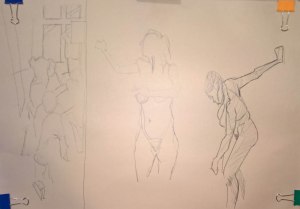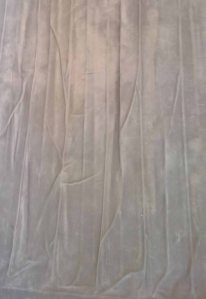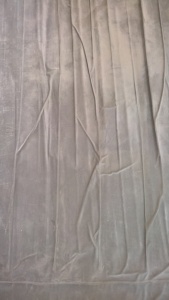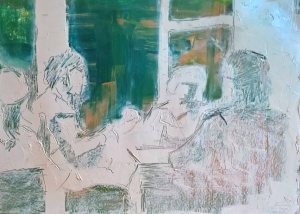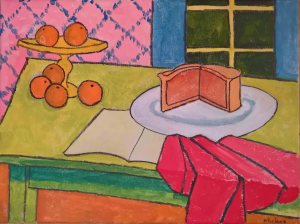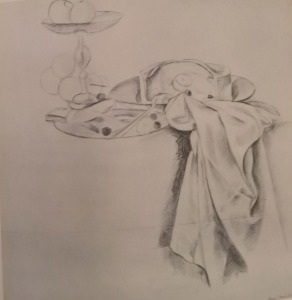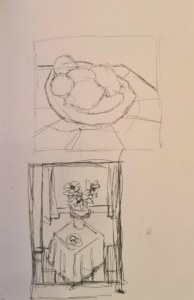Dearest Cleo
Here is the start of project 2, things are moving on quite quickly with the course, there is much to do before I leave for Florence in a months’ time.
Drawing 2 Investigating drawing
PART 1 Exploring Composition
Project 2 Using space
Elizabeth Blackadder is not an artist I would study by choice, I am not a fan of botanical art and although I know how hard it is to draw a believable cat, Freya just looked at me disdainfully, she is telepathic that cat I am sure, Blackadder’s cats don’t move me either. Backgrounds and space? everything seemed to be on a white background. I could notice that she had a tenancy to break the subject on the left hand edge of the picture frame and that there is almost always a margin at the right hand edge, presumably to keep the eye from drifting off the edge of the canvas.
I have never been quite sure which is the left or the right of a picture, but to avoid any confusion as we go on, I am using the terms from the beholder’s, or my point of view, where the right hand edge of the picture is on the right of my field of vision as I look at the painting or the side of the picture where I would pick up the knife if the picture was, in fact, a table mat.
I’m glad we have cleared that one up, there are only one other to go. Researching paintings and drawings on the internet is a soulless business, apart from the fact that no one it seems can spare the time to put the medium or even the size of the works on their pin interest boards, gives one cause to flounder at the first hurdle, but the images themselves seem devoid of the hand or the eye of the artist, these pitfalls are particularly relevant with contemporary artists. It isn’t so bad when looking at graphite, charcoal or ink works because you can guess the real size from the width of the marks, but with paintings it is a minefield. How often have you been overwhelmed by the size of a Pollock, Veronese, Monet or Rothko that fitted very neatly into the book or screen you viewed? or astounded by the fact that Van Eyck self portrait in real life is smaller than your ipad screen? More astonishing than this is that the preliminary judging for the Royal Academy Summer Show is done virtually, works twice removed, once by photography and once by virtual reality. Me, I wouldn’t even buy pyjamas off the internet, I don’t buy pyjamas anyway, I am talking metaphorically here, but if I did buy pyjamas I would need to count the threads and feel the touch of the material between my fingers. It is with the greatest of apologies that I will continue to pass judgement and opinion on the practice and work of Elizabeth Blackadder without ever having seen her original work.
I chose three paintings to discuss, The Bullfighter, Chinese still life with Arum lilies and Still life with Iris’ and I will consider each in turn. Starting with The Bullfighter.
The painting is 825 x 550 mm while it is not a still life it does seem to be a careful consideration of space. My eye enters the picture at the bullfighter’s hand, the dominant bullfighter breaks the left edge of the picture frame with his elbow my eye flows across the darker tones at the top of the picture, down the pink and blue right margin then investigates the impressionistically rendered arena visible through the door opening before returning to the bullfighter.
Blackadder has for me captured the moment before the bullfighter enters the arena, there seems to be a look of trepidation on his face, his last moment of quiet contemplation before entering the fray. The light is another thing that rings really true the high key tonal range of the arena visible through the doorway is reminiscent of the hot Spanish mid afternoon sun which contrasts well with the cooler darker interior tones, the gap in the middle of the tonal range extenuates the difference between the two contrasting ends of the tonal range. The contrast is intensified by the detailed rendering of the figure as opposed to the abstract marks of his surroundings. The overall composition is very modern reminiscent of a photograph taken quickly as the opportunity arose without recourse to the traditional rules of composition.
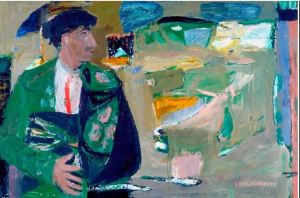
Figure 1 (17 02 15 01) The Bullfighter by Elisabeth v Blackadder oil painting 82.5 x 55
The Bullfighter was painted in 1961 in the early part of Blackadder’s career my other two choices are from much later in her career, the first of which is Chinese still life with arum lilies.
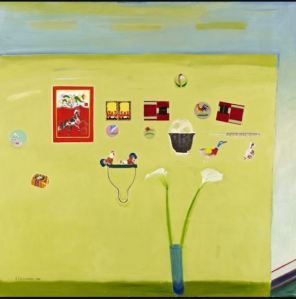
Figure 2 (17 02 15 02) Chinese still life with arum lilies, by Elisabeth V Blackadder oil painting
Blackadder arranges her still lives, not on a tabletop in the traditional manner but vertically on a wall, this frees her from the traditional still life arrangement and allows her objects to roam the picture plane in an almost Mondrian like manner giving her much more compositional freedom. She maintains the empty margin on the right hand edge of her canvas using a reversed C shape to frame her composition. She has again the tonal gap between her objects and the ground which allows her objects to float in front of the the surface of the wall.
The objects are very detailed with a Chinese theme and are hard edged, with the exception of the lilies, this serves to make the lilies stand out and become the main subject of the painting. That the lilies are grounded on a surface in front of the wall serves to force them forward in the picture plane. If the objects were painted without detail, this would further enhance the abstract Mondrian like feel of the work but the detail gives a Chirico dreamlike feel to the work.
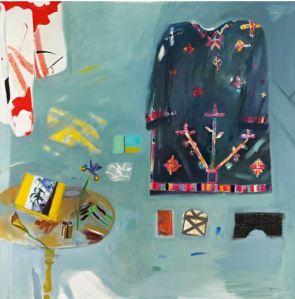
Figure 3 (17 02 15 03) Still life with irises, by Elisabeth V Blackadder oil painting
My final choice, Still life with irises, whilst retaining the surrealist feel, owes more than a passing nod to Matisse, the bright colouring gives a cheerful mood to the painting. Again the objects seem to float in front of the vertical ground and she has maintained the right hand margin that is so characteristic in her work. The left hand and top edge of the canvas break the forms leaving me with an desire to complete the forms and thereby extend the painting. Although the background has a consistent feel to it, the detail that Blackadder has given to it is overwhelming on closer inspection; it could stand as a painting in its own right without the addition of the objects.
Blackadder fits the mould of the great British artists’ in that like Turner, Bacon and Freud she is a maverick, difficult to pigeonhole into a school or a movement. Well that was quite an experience, a non-Blackadder fan becomes converted and is looking forward to seeing some of her work in the flesh, over the course of a thousand word essay, but I am still not sure about the botanicals and the cats.
Yours
Mickos
